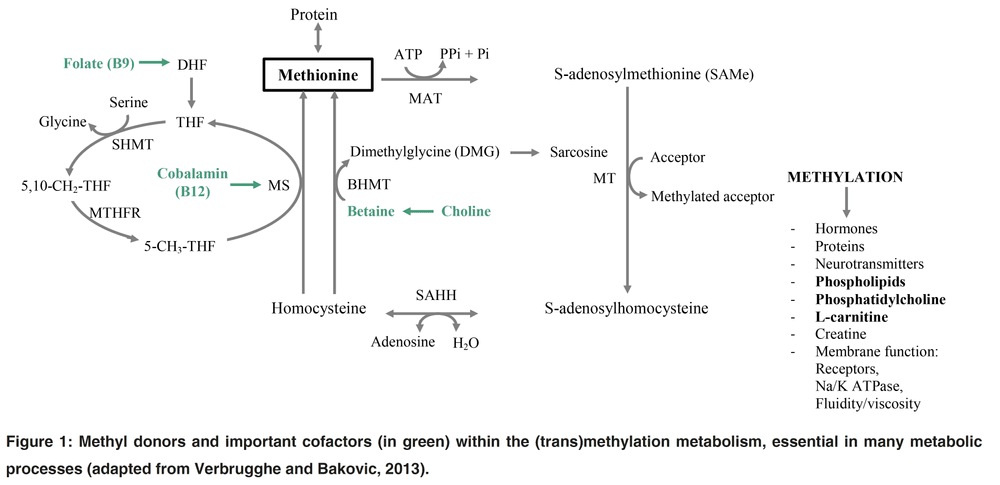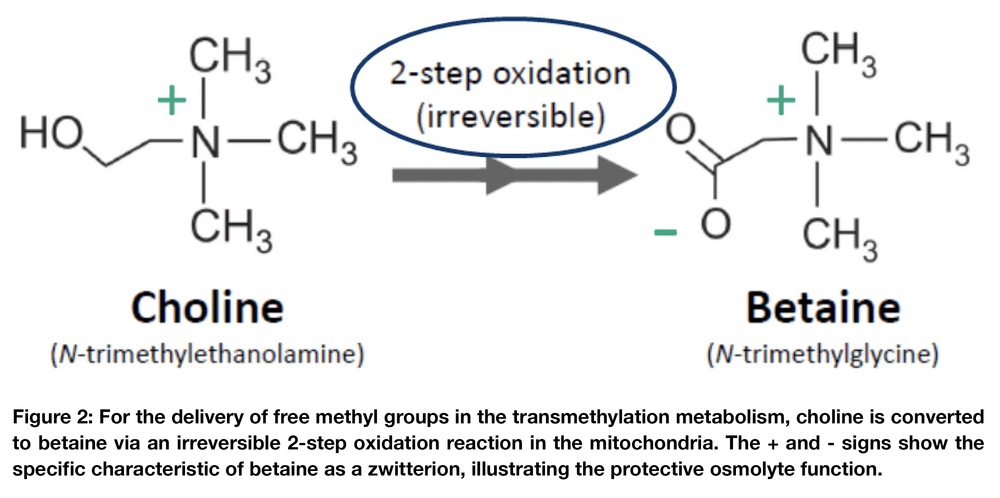The Unrivalled Benefit of Betaine in Pet Food
Pet Food Supplement, May 2023
Betaine is a functional nutrient with interesting osmoprotective properties and is a well-known methyl (CH3) donor in animal metabolism. In spite of the beneficial functionality of betaine in animal nutrition, there is no nutritional requirement identified for the application of betaine in pet food. The nutrient is not even mentioned in the Nutrient Requirements of Dogs and Cats (NRC, 2006) or in the latest FEDIAF Nutritional Guidelines (2021). Yet, particularly based on recent research, betaine has some unique properties to support pet health and pet food production.
Methyl donors and transmethylation
In the animal body, betaine is a natural metabolite in the transmethylation metabolism (Figure 1). Like folate (vitamin B9), cobalamin (vitamin B12) and choline, betaine has a specific role in the existing methyl transferation pathways to remethylate homocysteine into methionine. Although there is no specific requirement described for the total amount of methyl donors in pet food, a certain balanced minimum of these different methyl group donors is needed1. Methylation is involved in many important metabolic processes and in the expression of genes (DNA-methylation). The methyl group donations are also essential to maintain normal liver function, like the prevention of fat accumulation in the liver (read more about fatty liver prevention in the blue box).
Choline in the metabolism
In the classical sense, choline is not a true vitamin as animals are able to synthesize choline in the liver. Yet, choline is traditionally added within the vitamin B-complex to pet food, as the de novo synthesis can be inadequate under some conditions. Supplementation of the diet with small amounts of choline can prevent certain pathological conditions. Choline, per se, is essential as a building block for acetylcholine and phosphatidylcholine. Acetylcholine is an important neurotransmitter that plays a role in body functions such as muscle contractions. Phosphatidylcholine is a structural component of (cell)membranes and is a required element of very low density lipoproteins (VLDL). VLDL are crucial in the energy metabolism and prevention of fatty livers, as they play an important role in the mobilisation of triglycerides from the liver and their delivery to other animal tissues. Like in other animal species, suboptimal concentration of (phosphatidyl)choline in the pet’s diet is associated with a reduced capacity of the liver to synthesize VLDL, which results in the accumulation of fat in the liver of dogs and cats1. A second functional role of choline is the delivery of methyl groups for transmethylation reactions (Figure 1). As a methyl donor, choline provides active methyl groups for the remethylation of homocysteine into methionine. From methionine, S-adenosylmethionine (SAMe) can be formed. SAMe is involved in more than 60 metabolic reactions, which play an important role in a multitude of metabolic pathways, such as cell replication, synthesis of neurotransmitters, phosphatidylcholine, phospholipids, L-carnitine and membrane functions1.

Choline vs. betaine as a methyl donor
Betaine is closely linked to choline due to its relationship within the transmethylation pathway, which allows for the use of betaine to partly or completely replace choline chloride in animal diets. Both dietary components can be supplemented to the feed, to be used as a methyl donor in the transmethylation metabolism (Figure 1). For the delivery of free methyl groups, choline needs to be converted into betaine via an irreversible 2-step oxidation reaction in the mitochondria (Figure 2). The required conversion of choline into betaine makes betaine a more efficient methyl donor compared to choline.

Betaine as a protective osmolyte
Supplemented betaine, which is not used as a methyl donor, can be used by (stressed) cells as an osmoprotectant. As a complete molecule, betaine has a neutral charge, but it has a region of both positive and negative charges (Figure 2). Having this specific characteristic, betaine is a zwitterion (dipolar ion) and this allows betaine to be both highly water soluble and able to hold water molecules. When betaine is taken up inside cells, it increases the water retention capacity of the cells. Thereby, betaine improves the cellular water balance in the gut, muscle and animal tissues. A better water balance by organic osmoprotectants, such as betaine, relieves the pressure on the ion pumps and stabilises the electrolyte concentration in and out of the cell. Thereby, betaine protects cells from the negative effects of dehydration, which results in reduced cellular activity, protein denaturation and loss of enzyme production. Higher plasma levels of betaine are advantageous, as it will increase the tolerance of cells to unfavourable conditions (e.g. in cases of renal failure).
Research with betaine in cats and dogs
The replacement of choline chloride with betaine in diet formulation is common practice in livestock nutrition. In pet food, there is less experience with the exchange of both functional nutrients. Until a few years ago, no scientific research was available about betaine in pet diets. Recently, several articles have been published and it is now clear that both dogs and cats can use betaine as a methyl donor, gain benefit from the osmoprotective function, and utilise other functionalities.
Choline used to compensate for low betaine levels
In a cross-over study with healthy dogs, comparing a traditional dry extruded diet with a plant-based diet, the circulating plasma levels of betaine and choline were both lower when the plant-based diet was fed2. The background level of betaine in the plant-based ingredients was significantly lower (Table 1), explaining the lower betaine levels in the plasma. However, the dietary choline levels were comparable between both diets due to the supplementation of choline chloride (on top of the choline present in food ingredients). The observed lower choline plasma levels could be explained by a lower absorption and/or de novo synthesis of choline in dogs receiving the plant-based diet. Alternatively, the lower plasma choline could be explained by the increased oxidation of choline to form betaine, for the delivery of sufficient methyl groups 2. This suggests that in dogs, more choline will be used as a methyl donor, to compensate for low betaine levels within pet food.
Betaine is a methyl donor in pets
Supplementation of betaine in pet food resulted in higher betaine plasma levels in both dogs 3,4 and cats 5,6. Moreover, additional dietary betaine increased different serum metabolites related to the transmethylation metabolism (Figure 1), including choline, dimethylglycine (DMG), sarcosine and methionine3,4,5,6. Levels of choline and several phosphatidylcholines were also elevated in healthy cats6, cats with chronic kidney disease6 and dogs with early renal disease4, when they received additional betaine in their diet. In all cases, the dietary choline levels were comparable between the control and test diets (Table 1). Indicating that choline is spared as a methyl donor by the addition of dietary betaine and thereby, choline can be used for other purposes like phosphatidylcholine synthesis. Besides, via the transmethylation metabolism (Figure 1), the methyl groups donated by betaine can also be used (via SAMe) for the synthesis of phosphatidylcholines. Collectively, phosphatidylcholine levels can be elevated by betaine supplementation via different routes 6. Results of the different studies demonstrate that betaine can replace (a proportion of) choline chloride in pet diets.

Betaine and omega-3
In cats and dogs, betaine had significant beneficial effects on the lipid metabolism and the circulation of different beneficial polyunsaturated fatty acids (PUFA). The addition of betaine to both a dog renal diet 4 and an adult dog diet enriched with omega-3 (eicosapentaenoic acid, EPA) 3, increased the circulating plasma levels of DHA (docosahexaenoic acid ) and EPA in dogs respectively. Although somewhat different to the responses to the addition of dietary PUFA’s, cats receiving diets with flax seed (source of α-linoleic acid, αLA) or fish oil (source of EPA&DHA) also showed increased circulating levels of the specific fatty acids from the addition of betaine 5. Interestingly, complementary effects of betaine and fish oil were found. The addition of both compounds to the diet was shown to support the immune response and lower the inflammatory status in cats.
Betaine advised in feline diets enriched with PUFA
In the strictly carnivorous cat, dietary supplementation with omega-3 (EPA&DHA) or omega-6 (ARA, arachidonic acid) resulted in significant changes in plasma values related to the transmethylation pathway7. In both dietary cases, the addition of the PUFA sources resulted in lower circulating levels of betaine, dimethylglycine and sarcosine (Figure 1) compared to cats fed with a control diet lower in PUFA. This is an interesting finding, as it has not previously been reported that PUFA supplementation influences the betaine levels in other animal species, according to the researchers. In a follow-up study, betaine was added to feline diets enriched in omega-3 and omega-6 sources. Additional betaine increased the uptake of the PUFA, clearly showing that stimulating the transmethylation pathway influences fatty acid metabolism5. In another feline study, the plasma levels of EPA and DHA were elevated by the addition of betaine and prebiotic fibres, despite the fact that the control and test foods contained similar levels of EPA and DHA6. An increased uptake or reduced degradation of EPA and DHA by the use of betaine may explain the elevated plasma levels of the beneficial omega-3 fatty acids. In conclusion, betaine has beneficial effects on the metabolism of PUFA in cats and it is advised to supplement betaine into feline diets that are enriched with omega-3 and/or omega-6 fatty acid sources. In recently published trials, the supplementation of 0.5% betaine was used in pet diets.
Renal health
Betaine has a direct role in kidney health and function. For renal cells, osmolytes are highly important as these cells are exposed to hypertonicity by the urine (high concentration of soluble molecules outside the cell). Betaine, as an osmoprotectant, reduces the harm of hypertonicity by preventing the movement of water out of the renal cell. Therefore, this osmoprotective effect from betaine in combination with its functionality as a methyl donor aids in kidney health. The combination of betaine and soluble fibre had a positive effect on plasma and faecal metabolites in dogs with early renal disease, as levels of several uremic toxins are shown to decrease4. Cats with chronic kidney disease have difficulties maintaining their body weight. In a study with cats suffering from chronic kidney failure, a renal diet supplemented with betaine and prebiotic fibres could maintain the total body mass of the cats. In contrast, when these cats received the same diet without betaine and prebiotics, the cats lost body weight while the food intake was similar. In healthy cats receiving the same trial diets, no effects were observed on body weight 6. The effect of betaine and prebiotics in combination on body weight was thus unique for animals with reduced ability to utilise food.
Practical application in pet food
Betaine is naturally present in numerous animal- and plant-based raw materials used in pet food, but concentrations can vary significantly. As there is no official recommendation, betaine is not regularly added as a single additive to pet food. Choline is also naturally distributed in a wide variety of ingredients, particularly in animal-based products. The FEDIAF (Nutritional Guidelines 2021) recommends choline at a level of 1,640 mg/kg DM and 2,400 mg/kg DM for adult dogs and cats respectively. To reach these recommended choline levels in pet food, or to supplement higher choline levels when a specific health benefit is desired, choline chloride is widely used as a feed additive. Choline chloride is better not included in pet food premixtures, due to the high hygroscopicity and aggressive behaviour of choline chloride to other feed ingredients. In contrast, betaine hydrochloride, when used as an alternative methyl donor source providing betaine instead of choline, is a non-hygroscopic feed additive and easier to handle in premixtures and food. Although studies of the direct replacement of choline chloride with betaine hydrochloride in pet food are still missing, recent research in cats and dogs shows that betaine can replace choline in the metabolism of companion animals. Additionally, betaine has some unique benefits to support a long and healthy life of our best friends!




